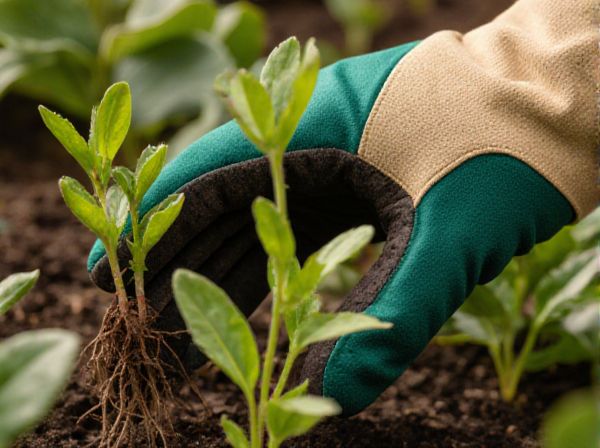
Bare root plants vs container-grown plants Illustration
Bare root plants offer cost-effective transportation and easier planting due to their dormant state and lack of soil, reducing weight and volume. Container-grown plants provide continuous growth with established root systems, enabling immediate landscaping impact and less transplant shock. Choosing between them depends on planting season, species tolerance, and desired establishment speed in the garden.
Table of Comparison
| Aspect | Bare Root Plants | Container-Grown Plants |
|---|---|---|
| Planting Season | Best in dormant season (late fall to early spring) | Plant year-round |
| Root Condition | Roots are exposed, trimmed, and dormant | Roots enclosed in soil, actively growing |
| Transplant Shock | Higher risk due to root exposure | Lower risk, roots protected |
| Cost | Generally less expensive | Typically more expensive |
| Shipping and Storage | Lighter, easier to ship but requires cold storage | Heavier, bulkier, no cold storage needed |
| Establishment Speed | Slower initial growth | Faster establishment and growth |
| Plant Size Availability | Usually smaller sizes available | Varied sizes from small to mature |
Understanding Bare Root Plants: Definition and Benefits
Bare root plants are dormant plants sold without soil, exposing their roots for easier handling and transplanting. These plants benefit from reduced shipping costs, quicker establishment, and less transplant shock compared to container-grown plants. Their root systems adapt rapidly to new environments, promoting vigorous growth and healthier development in gardens and landscapes.
What Are Container-Grown Plants? Key Features Explained
Container-grown plants are cultivated in pots or containers filled with soil or other growing media, promoting controlled root development and ease of handling. These plants exhibit minimal transplant shock due to an intact root system and consistent moisture levels maintained during cultivation. Ideal for year-round planting, container-grown plants offer extended availability and versatility for both landscaping and gardening projects.
Comparing Establishment Rates: Bare Root vs Container-Grown
Bare root plants generally establish faster than container-grown plants due to their undisturbed root systems, which promote quicker soil adaptation and nutrient uptake. Container-grown plants often experience transplant shock from root circling and limited root expansion, leading to slower establishment. Research shows bare root plants can achieve up to 30% higher establishment rates in the first growing season compared to container-grown counterparts.
Cost Differences: Which Is More Budget-Friendly?
Bare root plants generally cost less than container-grown plants because they are sold without soil and pots, reducing shipping and handling expenses. Container-grown plants carry higher prices due to the costs of pots, soil, and extended nursery care. For budget-conscious gardeners, bare root plants offer a more affordable option, especially for large-scale planting projects.
Root Development and Health: Key Considerations
Bare root plants often exhibit stronger root development due to minimal root disturbance and better soil adaptation, promoting healthier establishment. Container-grown plants may suffer from root circling and restricted growth, potentially leading to weaker root systems and transplant shock. Choosing the appropriate planting method depends on species-specific root architecture and site conditions to optimize plant health and longevity.
Seasonal Availability and Planting Windows
Bare root plants are typically available and planted during their dormant season, often in late winter to early spring, aligning with specific planting windows that take advantage of cooler soil temperatures and reduced transplant shock. Container-grown plants offer year-round availability and greater flexibility in planting time since their roots remain protected and established within the soil of the container. Selecting between bare root and container-grown plants depends heavily on the seasonal availability and the optimal planting window for the specific plant species and local climate conditions.
Ease of Handling and Transport
Bare root plants offer superior ease of handling and transport due to their lightweight, compact root system, reducing shipping costs and minimizing damage during transit. Container-grown plants, while heavier and bulkier, provide greater root protection and can be transported longer distances without risk of drying out. Nursery operations often prefer bare root plants for seasonal planting, whereas container-grown plants are favored for year-round availability and immediate transplant success.
Common Challenges: Pests, Diseases, and Stress
Bare root plants often face increased vulnerability to pests and diseases due to root exposure during transport and planting, leading to higher stress levels. Container-grown plants, while protected by soil, can suffer from root-bound conditions that promote fungal infections and pest infestations. Both plant types require vigilant monitoring and appropriate cultural practices to mitigate stress-related damage and maintain healthy growth.
Environmental Impact: Bare Root vs Container Options
Bare root plants have a lower environmental impact due to reduced plastic use and lighter transportation weight, which decreases carbon emissions. Container-grown plants often require more packaging and heavier shipping methods, increasing their carbon footprint. Choosing bare root options supports sustainable gardening by minimizing waste and energy consumption during plant production and delivery.
Best Practices for Planting and Aftercare
Bare root plants require planting during dormancy with roots soaked in water before setting in well-drained soil to prevent drying out, while container-grown plants benefit from maintaining moist root balls and loosening circling roots before planting. Optimal aftercare includes consistent watering, mulching to preserve soil moisture, and monitoring for pest infestations or root rot symptoms in both bare root and container-grown plants. Proper timing, soil preparation, and acclimatization reduce transplant shock and promote healthy establishment.
Bare root plants vs container-grown plants Infographic

 gardendif.com
gardendif.com